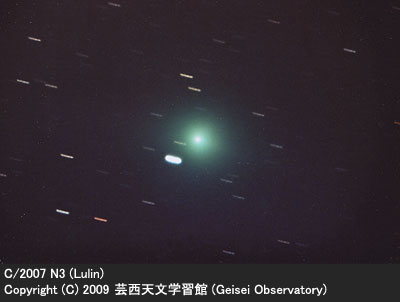C/2007 N3 (Lulin) and visual magnitude estimates
C/2007 N3 (Lulin) is glowing in the predawn sky and getting
closer to the earth. Currently its magnitude is from 7th to 8th and hasn't
brightened as much as initially predicted. The coma with a solid nucleus
is a beautiful green. I haven't see a bright comet like this for some time.

C/2007 N3 (Lulin)
16-minute exposure at 4:34, February 2, 2009, J.S.T.
70cm f/7 reflector, ISO 800 negative color film
Photographed by Tsutomu Seki
In photographs this comet appears to be at the 8th magnitude,
almost the same brightness as a nearby bright star. It is not easy to visually
estimate the magnitude of a comet because the fuzzy image of a comet has
to be compared with a pinpoint image of a star. It is often advised to
compare the extrafocal image of a comparison star with the image of the
comet. The telescope must be defocused to the extent that the out-of-focus
star image either inside or outside the focus equals the diameter of the
comet. However, many observers point out that this tends to underestimate
the magnitude of the comet because the comet's brightness decreases as
the comet itself is put out of focus. At a Comet Conference held in Tokyo
in the 1970s, Mr Koichiro Tomita of the National Astronomical Observatory
said that, contrary to this popular notion, we could overestimate, not
underestimate, the comet's brightness. As the images of the star and the
comet are being gradually defocused, the star image loses its brightness
at a much faster rate than the fuzzy image of the comet does. Mr. Kiichiro
Furukawa of the same observatory said that the values obtained by this
method would differ depending on whether the inside focus image or outside
focus image is used.
I think this is a very important issue worth serious consideration.
I tested this myself by comparing the defocused images using Comet Lulin.
I estimated the comet to be at 7th magnitude, roughly one magnitude brighter
than the nearby star. I am not sure which value is correct, but it may
not be desirable to defocus the image too much. The method I have been
advocating for many years involves defocusing the image to the extent that
the star image becomes a little larger than a pinpoint, avoiding too much
defocusing. It may not be easy, but less problematic. After this is achieved,
you make a magnitude estimate by the fractional method choosing a star
brighter than the comet and one fainter. Or use the step method and follow
the procedure for a magnitude estimate for variable stars. I prefer the
step method and my one step is 0.1 magnitude.
In case of a comet bright enough for binoculars, you may
be able to obtain a more accurate estimate because the amount of defocusing
is small. The method I occasionally use is to choose a number of stars
(more than 5, if possible; the more the better) close to the comet in a
wide field and average out the estimates. It will be more accurate than
a poorly applied fractional method using two stars with a large magnitude
difference.
There will also be a significant difference in results depending
on whether you observe under an excellent dark sky or near a large bright
city. In the urban areas you tend to underestimate the brightness of a
fuzzy object like a comet. I experimented with a comet in 1965 and found
that the difference was as large as one magnitude.
I believe that for the physical study of comet brightness
(i.e., the relationship between the heliocentric distance and brightness)
it is better to use the results obtained only by the same person using
the same observing site and same telescope. The comet's standard magnitude
and the coefficient of log R are often worked out from the empirical formula.
Because the comet occasionally displays unusual magnitude changes over
a short period of time, it is important to collect a wide range of data.
However, in case of a new comet with a near parabolic orbit, 10 is used
as the coefficient of log R in the magnitude formula assuming that the
comet's magnitude is inversely proportional to the 4th power of its distance
from the sun; and for a periodic comet which frequently returns, 15 is
used for the coefficient. These formulae have been commonly used without
major problems. Personally, I prefer these simple formulae to more complex
and cumbersome formulae.
Problems relating to comet magnitudes are awaiting future
research for solutions.

